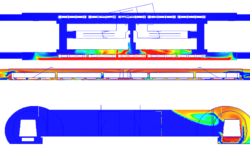18/1/2021
Tunnel ventilation system capacity and operation scenarios have been defined within the scope of the projects of Gebze Darıca Metro (11 stations, 15.4 km in length) and Fahrettin Altay-Narlıdere Kaymakamlik Metro (7 stations, 7 km in length). National and international standards, regulations and technical specifications were used.
In the studies, possible vehicle fire scenarios for tunnels and switch zones are simulated using Subway Environment Simulation (SES – tunnel ventilation). As a result, fan capacities were calculated and boundary conditions were determined for use in Computational Fluid Dynamics (CFD) analysis for station emergency cases.
Following SES analysis, 3D models of the stations were prepared and transferred to CFD modules to check the efficiency of emergency ventilation systems and of smokeproof and fireproof means of egress. The realistic outside air boundary conditions and the fans operating in accordance with the fire scenario in the event of an emergency were evaluated in conjunction with one another, and the tunnel boundary conditions were defined.
Determining fluid behaviour is crucial in engineering calculations. SES analysis – which is also defined as 1D analysis – was conducted assuming that parameters such as air, speed and temperature do not change in the horizontal (y direction) and vertical direction (z direction) of the tunnels, because the width and height of the tunnel are much shorter than the tunnel length. On the other hand, 3D analysis provides significant advantages in terms of time and cost in determining data such as heat transfer, pressure loss and flow rates in complex models.
Contact: Ulker Verenel – ulker.verenel@efectis.com



